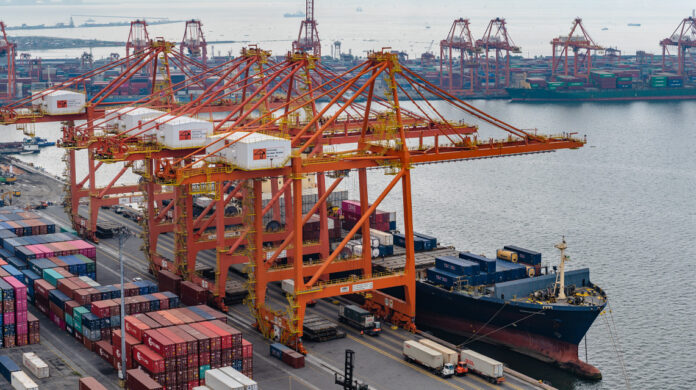-
International Container Terminal Services is speeding up the second phase of development of Berths 7 and 8 at Manila International Container Terminal
-
The development includes preparing back-up areas for the future Berths 9 and 10
-
Berths 1 to 5 and their back-up areas are also being refurbished
-
There are plans to add eight new hybrid rubber-tired gantries to the fleet of 32 hybrid RTG fleet
-
Environmentally sustainable initiatives include pioneering a sustainable river waste collection system for MICT’s immediate communities and a water ballast treatment system project
International Container Terminal Services, Inc. (ICTSI) is speeding up the second phase of development of Berths 7 and 8 at Manila International Container Terminal (MICT), including preparation of back-up areas for the future Berths 9 and 10.
In addition, ICTSI in a statement said it continues to roll out improvements, including environmentally sustainable initiatives, to further ease transactions, address stakeholder needs, and increase safety and security of port stakeholders.
The port operator is refurbishing Berths 1 to 5 and their back-up areas, which includes installation of an additional 450 reefer plugs for 40 footers and yard upgrade of Berths 1 to 5.
For eco-friendlier port operation, ICTSI plans to acquire eight new hybrid rubber-tired gantries (RTG) and add them to the 32 hybrid RTG fleet acquired starting 2018.
The new RTGs are expected to further improve service levels at the terminal and reduce emissions by 50% compared to previous RTGs.
ICTSI will also decommission MICT’s first quay crane this year and replace it over the next three years with three new quay cranes that can service larger vessels of over 12,500-twenty-foot equivalent units of capacity.
Moving away from traditional halogen and sodium lamps, MICT recently completed upgrading the entire terminal, including its yard and crane lights, to the more energy-efficient LED lighting systems. ICTSI said this will eliminate light spills and glare while lowering energy consumption, and save around 1.8 million kilowatt-hours per year and offset up to 1.09 million tons of carbon dioxide.
“With our strong focus on environmental stewardship, we understand how technological innovation goes hand in hand with our thrust to improve our ports’ air quality, energy consumption, and waste and water management. In line with this, we continually invest in port infrastructure and facilities that enhance our operational efficiency while simultaneously helping minimize our environmental impact,” ICTSI executive vice president Christian Gonzalez said.
A substantial part of ICTSI group’s 2022 budget has been earmarked for these MICT upgrades, which the company said are seen to further strengthen the terminal’s capacity to effectively serve the world’s larger box ships and accommodate the increasing volume that comes with a recovering economy.
Moreover, two environmental initiatives led by the social responsibility arm ICTSI Foundation continue to gain ground.
Cameras have been installed at the mouth of the Pasig River, the Philippine capital’s main waterway, as part of preliminary work for the foundation’s partnership agreement with Finnish non-government organization RiverRecycle to pioneer a sustainable river waste collection system for MICT’s immediate communities.
To address ballast water contamination from foreign ships, the foundation and the Diliman Science Research Institute continue to test prototypes for the foundation’s Water Ballast Treatment System Project. Upon completion of the protoptype, it can easily be carried on and off large cargo vessels visiting MICT to decontaminate ballast water prior to release into the sea.
For the long term, the device can be replicated and upscaled to help government comply with International Maritime Organization regulations related to the Ballast Water Management Convention of 2004, which mandates all signatory countries to establish their own ballast water treatment systems by 2028.
Despite the knock-on effects of the ongoing global supply chain disruptions affecting major hubs, ICTSI said yard utilization at MICT remains manageable, according to data from the Philippine Ports Authority (PPA).
As of PPA’s September 2021 Performance Report, MICT’s average yard utilization is at 63.02%.
ICTSI said it continues to fast-track the movement out of the port of Manila of overstaying import containers to improve the port’s utilization rate as more imports loom.
To improve the mobility of trucks inside the terminal, additional truck ingress, equipped with optical character recognition, was made operational last April with additional automation to further improve gate service.
MICT also continues to engage with the Bureau of Customs to continue to improve services for the unimpeded and online release of cargo release, including reduced releasing time from filing of entry and more seamless X-ray and inspection procedures, ICTSI said.





